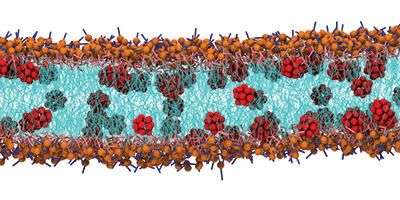Biocompatible Carbon Carriers
C fullerenes are hollow carbon nanoparticles that could be important for medical applications, such as drug delivery. One of the only known solvents for fullerenes that is both nontoxic and biocompatible are liposomes, yet little is understood about how to optimize liposomes for this purpose. Writing in Physical Review Letters, Jonathan Barnoud and colleagues at the French Institute of Health and Medical Research (INSERM) in Paris present simulations that reveal the properties of membranes that make them good solvents for carbon nanoparticles.
Liposomes are vesicles in which the surface membrane consists of a lipid bilayer. They are ideal candidates for drug delivery, as they can be used to encapsulate a wide variety of compounds and are made from materials found in our cells. But the interior of lipid bilayers is chemically similar to bulk alkanes, which are known to be poor solvents for fullerenes.
In their work, Barnoud et al. confirmed that liposomes incorporate fullerenes directly into their membranes, and they identified the molecular reasons for their increased dissolving power over alkanes. The group found that the dissolving power of liposomes arises from the high density of the membranes and from the packing of lipid chains in the membrane. Moreover, they predict that fullerenes will disperse evenly along the membrane, with minimal clustering. As liposomes can be formed from a number of different lipid molecules, their density and chemistry can be easily varied—features that could make them well-suited solvents for C fullerenes in medical applications. – Katherine Wright





